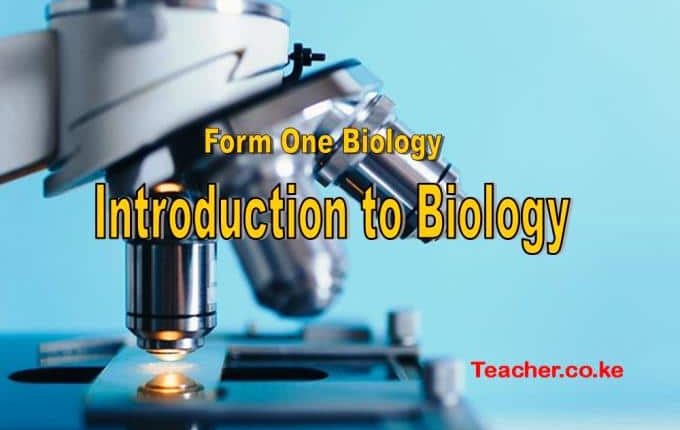Introduction To Biology
-
Biology derived from Greek words-BIOS meaning LIFE and LOGOS meaning STUDY or KNOWLEDGE.
-
Biology means “life knowledge”.
-
It is the study of living things/organisms.
Branches of Biology
- Botany – the study of plants.
- Zoology – the study of animals.
- Microbiology – the study of microscopic organisms.
- Morphology – the study of external structure of organisms.
- Anatomy – the study of the internal structure of organisms.
- Physiology – the study of the functioning or working of the cells or body.
-
Biochemistry – the study of the chemistry of materials in living organisms.
- Cytology – the study of cells.
- Genetics – the study of inheritance.
-
Ecology- the study of the relationship between organisms and their environment.
- Taxonomy – sorting out of organisms into groups.
- Histology – the study of fine structure of tissues.
- Virology – the study of viruses.
- Bacteriology – the study of bacteria.
- Entomology – the study of insects.
- Ichthyology – the study of fish.
Importance of Biology
- One learns about the functioning of the human body.
- One understands the developmental changes that take place in the body.
- It contributes immensely to improved life.
-
It enables one to enter careers such as:
- Medicine,
- Nutrition,
- Public Health,
- Dentistry,
- Agriculture
- Environmental Studies.
- Teaching
- Medicine,
Characteristics of Living Things
Life defined through observations of activities carried out by living things;
Nutrition –
- Nutrition is the processes by which food/nutrients are acquired/made and utilized by living organisms.
- Green plants and certain bacteria make their own food.
- All other organisms feed on complex organic materials.
Respiration –
- This is the breakdown of food to provide energy.
- The energy released is used for various activities in the organism.
Gaseous Exchange –
Process throw which respiratory gases(CO2&O2) are taken in and out through a respiratory surface.
Excretion –
- Excretion is the removal of metabolic wastes from the body.
- Substances like urea, carbon dioxide (Carbon (IV) oxide).
- These substances are poisonous if allowed to accumulate in the body.
Growth and Development –
- Growth means irreversible change in size.
- All organisms increase in size that is, they grow.
- Development is irreversible change in complexity.
- As they do so, they also become differentiated in form.
Reproduction-
Reproduction is the formation of new individuals of a species to ensure continued existence of a species and growth of its population.
Irritability –
- The ability of organisms to detect and respond to changes in the environment. This is of great survival value to the organism.
Movement –
- Is the progressive change in position from one place to another.
- Some organisms are sessile (i.e. fixed to the substratum).
- The majority of plants move only certain parts.
Collection and Observation of Organisms
Biology as a practical subject is learnt through humane handling of organisms.
Materials needed for collection of organisms:-
-
Knives to cut portions of plant stem/root or uproot.
- Polythene bags to put the collected plant or specimens.
-
Insect collecting jars.
-
Insect killing jars.
-
Hand gloves.
-
Sweep nets
-
Pooters
-
Traps
Observation of Organisms
- Observe the plant/animal in its natural habitat before collecting.
- Identify the exact place -on surface, under rock, on tree trunk, on branches.
- What does it feed on?
- How does it interact with other animals and the environment?
- How many of that kind of plant or animal are in a particular place?
- Plant specimens placed on the bench and sorted out into;- seeds/stems/roots/leaves/fruits.
- Animal specimens may be left inside polythene bags if transparent.
- Others (killed ones) are put in petri dishes.
- Use hand lens to observe the external features of small animals.
Presenting the Results of Observations
-
Organisms are observed and important features noted down: colour, texture hard or soft; if hairy or not. Size is measured or estimated.
-
Biological Drawings – It is necessary to draw some of the organisms.-
In making a biological drawing, magnification (enlargement) is noted.
-
Indicate the magnification of your drawing.
-
i.e how many times the drawing is larger/smaller than the actual specimen MG=length of drawing/length specimen
-
How to Draw
-
Several drawings of one organism may be necessary to represent all features observed, e.g.
- Anterior view of grasshopper shows all mouth parts properly, but not all limbs.
- Lateral (side) view shows all the legs.
Collection, Observation and Recording of Organisms
Collection
- Plants and animals collected from the environment, near school or within school compound using nets, bottles and gloves.
- Animals collected include:-arthropods, earthworms and small vertebrates like lizards/chameleons/ rodents.
- Place in polythene bags and take to the laboratory.
- Stinging/poisonous insects killed using ether.
- Other animals are observed live and returned to their natural habitat.
- Plant specimens collected include:- leaves, flowers and whole plants.
-
Observations are made to show the following:-
- Plants have roots, stems, leaves and flowers.
- Plants have roots, stems, leaves and flowers.
-
Animals have legs, hair, hard outer covering, feathers, eyes, mouth, limbs, and other appendages,
The differences between animals and plants collected
Comparison Between Plants And Animals
Plants |
Animal |
||
l. |
Plants are fixed in position and do not” move. |
l. |
Most animals move in search of food, shelter and mates. |
2. |
Respond slowly to stimuli. |
2. |
Respond quickly to stimuli. |
3. |
Cells have cellulose cell walls. |
3. |
Cells have no cell walls only a cell membrane |
4. |
Plants make their own food from simple |
4. |
Animals feed on already made food. |
materials such as CO2 and water using |
|||
light energy. |
|||
READ ALSO:
PHYSICS F1 NOTES: INTRODUCTION TO PHYSICS(Opens in a new browser



Comments are closed.